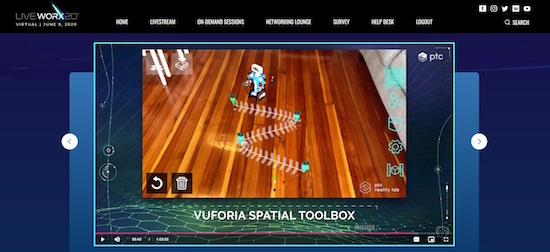PTC Embraces New Digital Reality
In a virtual LiveWorx keynote, CEO outlines how PTC’s product suite has enabled design and manufacturing productivity during a pandemic.

PTC president and CEO James Heppelmann opened the virtual LiveWorx event.
Latest News
June 9, 2020
As the global COVID-19 pandemic forced designers and engineers into work-from-home scenarios, many turned to cloud and software-as-a-service (SaaS) resources, as well as flexible licensing tools, in order to remain productive. The pandemic “forced us into a massive work-from home experiment at a global scale, and with little advanced planning and preparation,” said PTC president and CEO Jim Heppelmann in his virtual keynote address at PTC LiveWorx, which began live-streaming this morning.
In retrospect, current events make many of PTC’s acquisitions and product releases seem almost prescient. Many of its tools, particularly WindChill and OnShape, were tailor made for distributed engineering.
PTC itself was able to orchestrate the release of Creo 7.0 (what Heppelmann described as the most significant upgrade since the product was first unveiled) while its employees were also working from home.
As Heppelmann notes, however, the ability to remain productive from home is limited to knowledge workers. People who work on the frontlines of any industry (roughly 75% of the global workforce) have to do their jobs in the real world, and digital transformation initiatives have not affected them much, if at all. Heppelmann hopes that PTC can help change that, by extending digital tools into the field.
Of course, engineers have also struggled with remote work, as many of them rely on workstations that are anchored to their offices and corporate networks. “May have been forced to use a virtual desktop infrastructure, which is far from ideal,” he said. “The world of engineering software simply has to go to the cloud.”
Heppelmann noted that OnShape has been particularly useful in the current environment, particularly among university and high school engineering programs.
He outlined a number of use cases that demonstrate how PTC’s products have helped enable design, engineering and supply chain flexibility. Warehouse robotics firm GrayOrange, for example, was able eot leverage WindChill for PLM to enable remote review and release of designs during the recent shutdown. Engineers at Garrett Motion were likewise able to continue collaborating using OnShape. Electric vehicle company e.GO is using PTC’s software to enable a new franchise model that allows them to safely and securely share data with partners and franchisees.
Heppelmann also described how PTC’s tools can be used to extend the digital world into manufacturing and field service using augmented reality and the Internet of Things (IoT).
On the AR side, that has happened via tools like Vuforia Chalk, Vuforia Studio, and Vuforia Expert Capture. “AR is the front line equivalent of the tools that knowledge workers rely on,” Heppelmann said.
Supporting Customers
Heppelmann also described the ways PTC has supported its own customers during the pandemic, including adopting flexible licensing and providing “white glove” support to customers in the healthcare technology space.
PTC made Vuforia Chalk free during the crisis (an offer that has been extended into August). According to the CEO, 10,000 companies have tried out the AR tool for the first time. PTC also provided free access to OnShape for educators, and the software has gained a 5 to 10 percentage point increase in education market share in three months.
Spatial Computing
Finally, Heppelmann provided a preview of PTC’s next big initiative—spatial computing. The concept marries AR, artificial intelligence, the IoT, and other technologies in what he described as the “ultimate example of physical and digital convergence.”
 Vuforia Spatial Toolbox can enable PTC's vision for spatial computing.
Vuforia Spatial Toolbox can enable PTC's vision for spatial computing. PTC’s tool for this type of application is the Vuforia Spatial Toolbox. Combining data from existing tools (AR, CAD, PLM, etc.) with depth-sensing cameras and AI, spatial computing can “create an amazingly powerful 3D digital twin that understands all the dimensions of people, product, process, and place,” Heppelmann said. “It’s the ultimate way to monitor and optimize entire work sites, and every asset and worker involved in the process.” Using computer vision, spatial computing can apply analytics to what is happening in real time to better understand performance of any system.
Moving forward, Heppelmann expects cloud, SaaS, IoT, and other tools that enable remote work to gain even more ground. “When uncertainty and disruption become the expectation, then accelerating digital transformation is the ideal response,” he said.
More PTC Coverage
Subscribe to our FREE magazine, FREE email newsletters or both!
Latest News
About the Author
Brian Albright is the editorial director of Digital Engineering. Contact him at de-editors@digitaleng.news.
Follow DE






